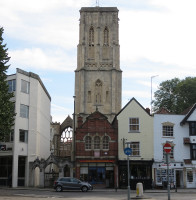
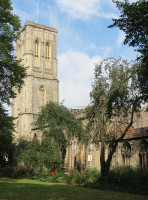
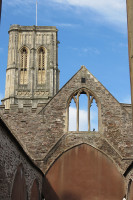
Temple Church, Bristol, different aspects.
Temple Church, Bristol, different aspects.


Just off Victoria Street is the ruined Temple Church, in a green space which remains something of an oasis of peacefulness among so much modern rebuilding in the area. The sculptural interest, which is the concern of these pages, is today rather slight. It was founded by the Knights Templar, and during restorations in the 19th Century, the foundation of an oval building was discovered: such oval or more usually round churches were a characteristic of the buildings put up by the Knights Templar, in emulation of the Church of the Sepulchre in Jerusalem: a complete specimen remains in London as Temple Church. But after the suppression of the Knights Templar the Church was entirely rebuilt in the 14th Century in more normal rectangular form, and most of the external structure is 15th Century, with the tower dating from around 1400 at the base and 1460 higher up. Refurbishment took place in the early 18th, late 19th and early 20th Century. The tower survives complete today, and the outer walls including their beautiful traceried windows, but the interior was entirely gutted in 1940 in the Blitz and is roofless, and put to grass, with just the pillar bases to show the dividing line between the nave and aisles, and a path to show the outline of the base of the original Templar church. Nothing of the inner wall surface, or the monuments which hung upon it, remains, except within the tower where a single Baroque monument survives, which can be seen obliquely from the outside. The font did survive, and was taken to a new church in southern Bristol (Holy Cross), and a 15th Century candelabrum, with a little statue of St Mary (a companion figure of St George is lost), which went to Bristol Cathedral, in the Berkeley Chapel.
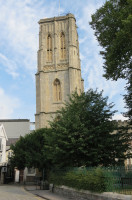
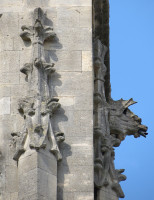 Leaning tower of Temple Church, and carving with gargoyle.
Leaning tower of Temple Church, and carving with gargoyle.
What do we see today then? The tower, as said, remains, of three stages, the top one being the tallest, the total height being about 113 ft, and it leans up to 5ft from the perpendicular, which apparently it has done for the past half millennium, despite the buttresses at the corners. Near the top, among the crocketing, are gargoyles in the form of dragons or some other, bearish beasts with small, spiky wings, and I would think these are from the Victorian restorations to the Church.
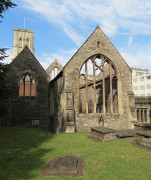
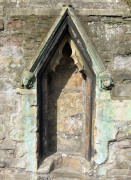
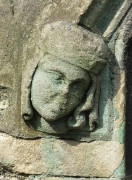 View from East, small blind window, and one of the two sculptured heads.
View from East, small blind window, and one of the two sculptured heads.
For the rest, the Church was built 159 ft long by 59 ft wide, a goodly size and larger than the other medieval churches of Bristol: only massive St Mary Redcliffe greatly exceeds it. We see five windows or bays per side, each broad Gothic window having five narrow lights, with crenellations above all the way along. The end has a massive window, again of five lights, and beneath this is a small trefoil window, blind, with a pointy outer frame, and at the corners, two carved heads, medieval in style, but likely as not Victorian, or reworked then. At the other end is the main entrance, Georgian Classical, with Corinthian side pilasters flanking the central Romanesque arch with a somewhat carved keystone, blank entablature and curved pediment above, enclosing a cartouche with what may be a Lamb of God, a symbol of the Templars, rather worn to be absolutely sure (it could also be a lion); a harmless little urn or pot is on top.
Around the walls and the open space are a few tomb chests, all ruinous, except for one massive one by a corner, which has two panels on each long side, perhaps the remains of a shield of arms at the end, and attached pillars someone like decayed figures between the panels and at the corners. Near to this on the external wall is a decayed panel monument, with the front and central panel missing, but which clearly was once a Classical piece, with side pilasters supporting a curved pediment, open at the base, enclosing a group of three winged cherub heads, of which the wings can still be seen. At the bottom, a gadrooned (corrugated) shelf survives, and an apron below this and two side brackets retain fragmentary but indistinguishable carving; perhaps a scroll with festoons of carved flowers. The other monument, inside the tower, is much more complete, but I could not read it from outside. The form is similar, with the central panel flanked by outer Corinthian pillars and one of an original pair of outer scrolls. The top border is curved, and filled with a winged cherub head; some broken pediment remains in part above it; perhaps a swan necked pediment with a central cartouche, once. Under the panel is a skull and foliage, then a jutting forward shelf under which are heavy brackets, scrolled, with an apron between with relief carving of hanging drapes.
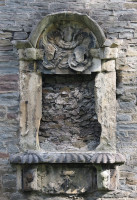 Ruined external wall monument with remains of three winged cherub heads.
Ruined external wall monument with remains of three winged cherub heads.
Before the destruction there was much more: brasses on the floor from the 14th and 15th and 17th Centuries; a monument to John Stone, Mayor of Bristol, d.1575 or thereabouts, and his four wives; John Hinde, Mayor, late 17th Century; Sir John Knight MP and Mayor, d.1691; Sir John Hawkins, d.1723; and Revd. Joseph Easterbrook, Vicar of Temple Church, d.1791. Perhaps the two partially-surviving monuments noted above are due to one or other of these, though John Stone would be too early.
Entrance to Temple Church, and Knight Templars' symbol of the Lamb of God.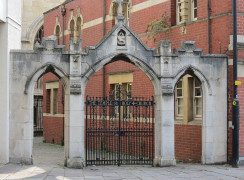
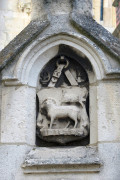
The way to the Church from Victoria Street is through a stone gateway with three entrances, an iron gate in the larger, central one and little buttressed turrets between the three, in a 19th Century Gothic revival style which is sympathetic to the Church and a medieval feel. Above the central gateway is a small Gothic window bearing a rather worn carving of the Lamb of God (the Templarís sign) on a shield hanging from a ring.
St Peter's Church, also ruined // St Mary le Port ruins // Christ Church with St Ewen // St Stephen's Church // Statues along Broad Quay, Bristol
Sculpture in England // Sculpture pages // Introduction to church monuments
Visits to this page from 2 Jan 2015: 7,465